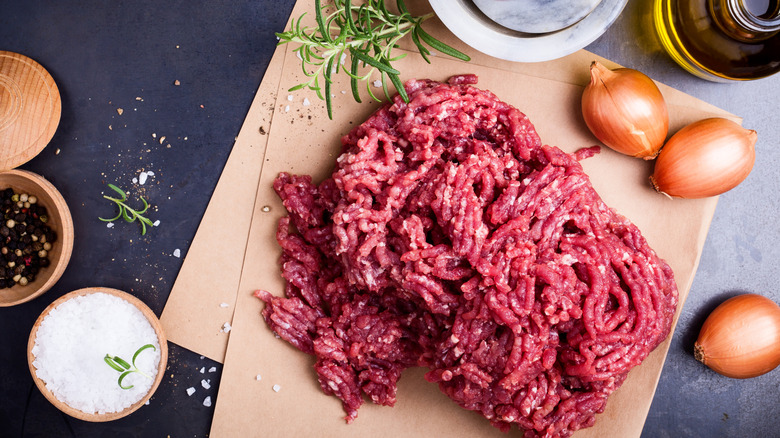Why Rinsing Your Ground Beef Could Pose A Safety Risk
Ground beef is an incredibly versatile ingredient; from juicy cheeseburgers to savory meatloaf, there are a litany uses for ground beef that has made it a staple ingredient in many home kitchens. Yet, like all raw meat, ground beef can pose certain food safety risks if improperly handled. While many people believe rinsing ground beef prior to cooking will mitigate these risks, this step is not only unnecessary, but potentially dangerous.
According to the USDA, not only does ground meat have more surface area that can potentially harbor harmful pathogens, but the process of grinding can mix any surface bacteria present throughout the meat. Contrary to popular belief, rinsing or washing ground beef doesn't kill these bacteria, but does increase the potential of pathogens being sprayed onto dishes and nearby surfaces through splashback. This cross-contamination increases the risk of foodborne illnesses such as Salmonella, Listeria, and E. Coli.
However, there is no need to panic! While rinsing your meat won't necessarily get rid of bacteria, cooking it properly will. Cooking ground beef to a minimum internal temperature of 160 degrees Fahrenheit will destroy any harmful bacteria that may be present. Be sure to always use a meat thermometer to ensure that your ground beef has reached the proper temperature before serving.
More tips for safely handling ground beef
Even before reaching the cooking stage, there are a number of ways to safely handle and store ground beef to mitigate the spread of illness-causing bacteria. When shopping, always make sure to check the "best by" date on the package, and look for signs of spoilage such as bad odor or sticky texture. While meat that is a little brown or gray in the center isn't necessarily spoiled, do avoid any ground beef that is completely gray inside and out.
Always refrigerate your ground beef as soon as possible after purchasing, and make sure that your fridge temperature stays below 40 degrees Fahrenheit. Ground beef should always be stored on the lowest possible shelf or on a plate or tray to prevent juices from dripping onto other foods. Since it has a very short shelf life, ground beef should be consumed within one or two days of purchase.
If left in the original packaging, ground beef can be stored in the freezer for up to two weeks. However, meat that is wrapped in heavy-duty foil or placed in freezer bags can last up to four months when frozen. You can also boil your ground beef prior to freezing to maintain the peak quality of the meat and remove the need for thawing before cooking. While raw ground beef may seem scary to handle, these tips can help you avoid any food-borne illnesses.


